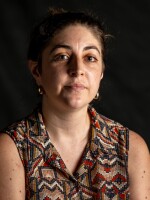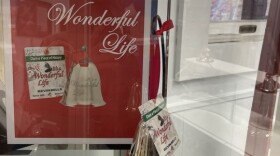Hunched over a piece of wood, Hank Sprouse whittles away in his basement workshop in Stratford, Connecticut. What looks like a simple carving now, will eventually become a realistic-looking cedar waxwing bird.
“The eye is going to be somewhere in here,” he says.
Sprouse is part of a dwindling community of bird carvers, a group of artists who make lifelike birds out of blocks of wood. It’s a meticulous process that includes photo research and reference materials, making sure all the features are anatomically correct, from the size of the bill to the design and color of each etched-in feather.
A former dentist, Sprouse jokes that the drilling comes easy to him. The hard part is making sure the glass eyes point in the same direction.
“I think my wife has corrected me on all but maybe four or five on the eyes,” Sprouse says. “She says, ‘No, up, down, in or out.’ She's got a hand in every carving I've ever done, I think. So that's fun for her and it's fun for us.”
Bird carvings, especially of waterfowl birds like ducks, were initially used by hunters to attract and capture real birds. A duck decoy, for instance, might have lured a real duck, thinking there was food nearby or that the area was safe to rest in. The earliest decoys were made from reeds by Native Americans, with colonial settlers turning to wood carvings in the 1700s.

But as the number of bird hunters has declined, so too has the need for decoys, freeing the carvings to be more elaborate and artistic than purely functional. Over time, bird decoys have come to be considered a form of American folk art – with decoys housed in art museums, including the Smithsonian American Art Museum.
“It's gotten so sophisticated and breathtaking,” says Sprouse, who’s been making decoys since the 1980s. He remembers when the world championship in waterfowl carving, an annual competition held in Ocean City, Maryland, was filled with carvers and spectators.
“Elbow to elbow, room to room. There was no extra space anywhere. And that's just kind of slowly declined,” he says.
That decline is due, in part, to a lack of new, younger people taking up the craft, he says. Many of today’s bird carvers are on the older side. Sprouse is 84 years old and says the majority of carvers he knows are over 60.
“I’m really sad to see it go in the direction it's going and I don't know what, if anything, will turn it around,” Sprouse says. “It is a true American craft and it's going to be a shame if that dies.”

This year, Sprouse used his decoy-making skills for a new purpose: to raise awareness of birds facing habitat loss. According to a 2019 study by the National Audubon Society, two-thirds of North American bird species are at risk of extinction due to climate change, including extreme heat in the spring and rising sea levels.
Sprouse and another bird carver, Alan Gabris of New Hampshire, created an art installation of more than a dozen decoys, representing birds from the endangered spoon-billed sandpiper to the extinct Bachman’s warbler.
“We’ve got to make more people aware of what's going on,” Sprouse says. “And that's what we tried to do.”
For Hank, the attention to detail is a meditative process. A sign in his workshop reads ‘bird carving is good therapy.’
“We've all got a talent that's in us and a lot of people never find it,” Sprouse says. “I just was lucky. I saw it and I found it and I love doing it. I love what my gift is. So I continue to do it.”

Áine Pennello is a Report for America corps member who covers the environment and climate change for Connecticut Public.








